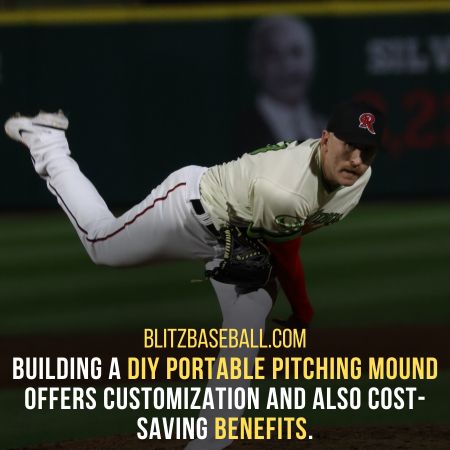A round portable pitching mound is a convenient and cost-effective option for baseball or softball players.
In this article, we explore the importance and history of pitching mounds, as well as the benefits of using a portable mound.
With the ability to use it in any weather conditions and the savings on inspection and rebuilding, building your own mound can be a practical choice.
How to build a round portable pitching mound? We provide step-by-step instructions, recommended sizes based on age and league requirements, and additional considerations to ensure a successful build.
Key Takeaways
- Pitching mounds enhance pitching performance, safety, and provide a suitable practice surface.
- They create game-like conditions for simulation and adhere to league regulations.
- Pitching mounds have evolved, standardized dimensions, and are used in professional and amateur baseball.
- Building a portable pitching mound offers customization and cost-saving benefits, while buying one offers convenience and limited customization options.
How To Build A Round Portable Pitching Mound?
The components of a pitching mound, such as the pitching rubber, slope, and landing area, are crucial for providing a suitable surface for baseball or softball practice.
The pitching rubber is the starting point for the pitcher and is typically made of rubber or synthetic material. It is embedded in the center of the mound and provides a stable and consistent position for the pitcher.
The slope of the mound is designed to create an optimal angle for the pitch, allowing for maximum velocity and movement.
The landing area is the portion of the mound where the pitcher’s foot lands during the delivery. It must be firm and level to ensure proper balance and prevent injuries.
Customization options for the components include different materials and sizes to suit individual preferences.
Maintenance requirements include regular grooming, leveling, and repair to ensure a safe and consistent playing surface.

Suitable Sizes for Different Ages
For different age groups, it is important to select suitable sizes for pitching mounds. The size of the mound directly impacts the performance and safety of the pitchers. Here are three key considerations for selecting the appropriate size:
-
Age and skill level: Younger players, such as those in Little League, benefit from smaller mounds with a lower slope. This allows them to develop proper pitching mechanics without straining their arm. Older players, on the other hand, require larger mounds that resemble regulation size to prepare them for game situations.
-
League requirements: Different leagues may have specific regulations regarding mound dimensions. It is crucial to adhere to these guidelines to ensure fair play and a level playing field for all teams.
-
Practice guidelines: Baseball Coaches should consider the purpose of the mound during practice sessions. Smaller mounds can be used for drills and refining technique, while larger mounds are suitable for simulating game-like conditions.

Building vs. Buying
When deciding whether to build or buy, individuals should consider their personal skills and preferences.
There are pros and cons to both options.
Building a portable pitching mound allows for customization and the satisfaction of creating something from scratch. It also gives individuals the opportunity to save money, especially if they already have the necessary tools and materials. However, building a mound requires time, effort, and technical know-how.
On the other hand, buying a portable pitching mound offers convenience and saves time. Individuals can simply select a ready-made mound that meets their requirements. However, this option may be more expensive, and individuals may have limited customization options.
Ultimately, the decision between building and buying depends on personal preferences, budget, and the individual’s ability to undertake a construction project.

Frequently Asked Questions
How much does it typically cost to build a portable pitching mound?
The cost of building a portable pitching mound can vary depending on factors such as materials used, size, and level of expertise. DIY options can range from $200 to $500, while professional installation can cost upwards of $1,000. Cost considerations should be carefully evaluated based on personal skills and preferences.
Are there any regulations or guidelines regarding the height of a pitching mound?
Pitching mound height regulations and guidelines vary based on the level of play. In professional baseball, the mound must be 10 inches high, while in high school and college it is typically 6 inches.
Can a portable pitching mound be used for both baseball and softball practice?
A portable pitching mound can be used for both baseball and softball practice. However, there are pros and cons to consider. The mound’s size and slope may need to be adjusted to accommodate the different pitching distances and techniques used in each sport.
How long does it take to build a portable pitching mound?
Building a portable pitching mound typically takes a few hours to complete. The time required may vary depending on the individual’s skill level and familiarity with construction. Additionally, the cost of materials can vary based on the quality and type chosen.
Can a portable pitching mound be easily transported and stored?
A portable pitching mound can be easily transported and stored due to its lightweight design and compact size. This durability allows for convenient practice sessions and the ability to use the mound in various locations. The advantages of using a portable pitching mound include versatility, cost-effectiveness, and ease of maintenance.
Conclusion
In conclusion, building a round portable pitching mound is a practical and cost-effective option for baseball or softball players. This article has provided a comprehensive guide, outlining the importance and history of pitching mounds, as well as the benefits of using a portable mound.
It has discussed suitable sizes for different ages and explored the pros and cons of building versus buying a mound. With step-by-step instructions and a list of necessary tools and materials, individuals can easily construct their own mound.
By following these guidelines, players can enjoy the convenience and versatility of a portable pitching mound.
